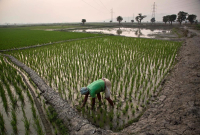Support strong Canadian climate journalism for 2025
The ground is so dry and deeply cracked on Todd Lewis's farm in southern Saskatchewan that he says if a wrench is dropped down one of the crevasses, "we'll never find it."
"If you dropped a rod down there that was eight or nine feet long, you wouldn't hit the bottom of that crack," Lewis told The Canadian Press. "It would disappear."
Lewis, who is also president of the Agricultural Producers Association of Saskatchewan, farms near Gray south of Regina, and the region has been extremely dry.
Environment Canada figures show Regina had only 1.8 millimetres of rain last month — the driest July in 130 years. It was the driest July ever recorded in the city of Moose Jaw, about 70 kilometres west of Regina. Moose Jaw got 4.3 millimetres of rain in July, less than the 4.6 millimetres it got in 1929.
It was also hot.
Regina had 11 days over 30 C in July. The city of Swift Current, about 245 kilometres west of Regina, saw 14 days over 30 C.
Lewis said canola is taking the hardest hit because of the heat and might only yield half the crop of an average year.
"We're always optimistic being involved in agriculture, but really we're going to have a down year, no question," he said.
But Lewis said areas south and west of his farm are in "a pretty desperate situation."
"A lot of cases, those fields won't even get combined, they're so poor," he said.
Ranchers in southern Saskatchewan are also facing poor grazing conditions and have scaled back hay cutting because of the hot, dry weather.
Trevor Hadwen, an agro-climate specialist with Agriculture Canada, said the agency is concerned.
"We know that producers in the southern portion of the province are looking at hay shortages or feed shortages for the fall and winter," said Hadwen.
Agriculture Canada's latest drought monitor map for July won't be out until next week but Hadwen says it will show severe drought conditions in much of southern Saskatchewan, with patches of extreme drought.
It's probably one of the fifth driest years on record for agriculture, but the situation is "no where near the impact of (1930) in terms of size or severity," Hadwen said.
"What we have this year is a fairly localized, intense drought situation that some crops are doing fairly well through and some crops are suffering," he said.
The dry conditions are also affecting water sources for cattle.
In mid-July, about 200 cattle were found dead in a pasture in southwestern Saskatchewan after they drank toxic water.
Provincial officials said hot weather caused evaporation, which left a sulphate concentration of more than 24,000 milligrams per litre in the water. Sulphate concentrations over 7,000 per litre can kill cattle.
There were 59 calls to Saskatchewan's Farm Stress Line in July — compared to 16 the same time last year.
Saskatchewan Agriculture Minister Lyle Stewart, who farms near Pense just west of Regina, said he's not surprised.
"Producers in the hardest hit areas are concerned," said Stewart. "They're seeing a crop that they put a lot of money into, and that got off to a pretty good start, deteriorate pretty rapidly through July.
"Guys are figuring out that they're going to have a tough time paying some of their bills and farmers just don't want to grow poor crops. It's a thing with us farmers, especially when you see a crop start off real good and look beautiful and then go downhill."
Stewart said any rain at this point would likely be too little, too late for most crops.
"Generally speaking, this crop is too far advanced to help now," he said.
In Regina, parched soil is also causing the ground to shift and that's pulling power meter boxes away from homes.
SaskPower, the Crown utility company, said seven meters caught fire over two weeks. About 800 of 2,000 meters inspected as of Tuesday needed repairs.
John Paul Cragg, a warning preparedness meteorologist with Environment Canada, said there is one thing to remember about the weather.
"Things in Saskatchewan can switch on a dime," he said. "It's very hard to tell what will happen with this dryness, whether it will persist, whether the precipitation pattern will change and they'll start seeing more precipitation in the south."





Comments